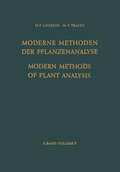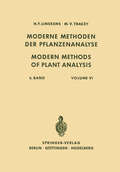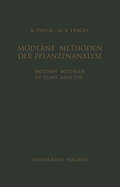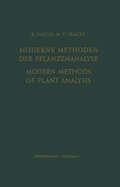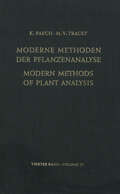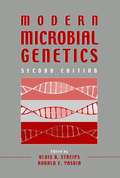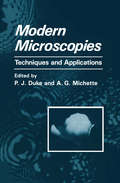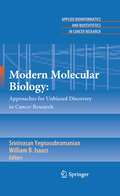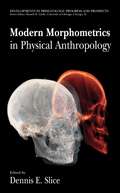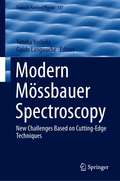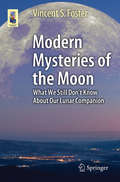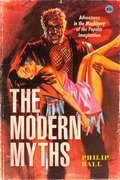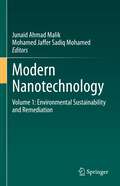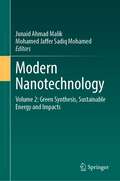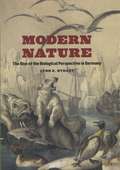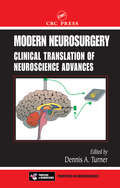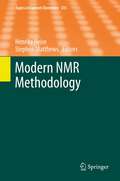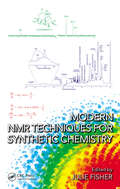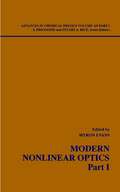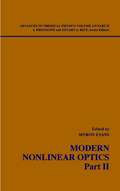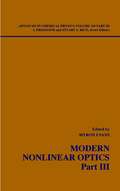- Table View
- List View
Modern Methods of Plant Analysis / Moderne Methoden der Pflanzenanalyse (Modern Methods of Plant Analysis Moderne Methoden der Pflanzenanalyse #5)
by K. Biemann N. K. Boardman B. Breyer S. P. Burg W. L. Butler D. J. David P. S. Davis A. E. Dimond A. C. Hildebrandt F. A. Hommes O. Kratky H. F. Linskens H. Moor K. H. Norris I. J. O'Donnell J. V. Possingham H. Prat D. H. Slogteren E. Stahl J. A. Veken J. P. Want E. F. Woods123 phase and hence have no direct bearing on the retention time of solutes. However in gas-solid chromatography, a considerable quantity of the mobile phase may be adsorbed on the surface of the stationary adsorbent which diminishes the column's effective length and ability to retain solutes. In this respect helium has been found to be preferable to most other gases (GREENE and Roy, 1957) because it is adsorbed to the least extent. 3. Packed columns offer a considerable resistance to flow, which may create a pressure differential between inlet and outlet of sufficient magnitude to cause an unfavorable flow rate through a significant length of the column. A reduced inlet/outlet pressure ratio can be obtained by using light molecular weight gases toward which the column packing shows the greatest permeability. The flow rate of the mobile phase is normally adjusted by altering the column inlet pressure, for which purpose commercial pressure regulators of sufficient accuracy are available. Quantitative measurements of the flow rate can be made by a number of methods, including rotameters, orifice meters, soapfilm flow meters and displacement of water. The former two methods are the most con venient but the least accurate; moreover they create a back pressure and are temperature dependent whereas although the moving soap bubble is cumbersome to employ and unusable for continuous readings, it is preferred when the highest accuracy is required.
Modern Methods of Plant Analysis / Moderne Methoden der Pflanzenanalyse (Modern Methods of Plant Analysis Moderne Methoden der Pflanzenanalyse #6)
by H. F. Linskens M. V. Tracey Ulrich Beiss Fay Bendall Walter Björk F. Bohlmann Hans G. Boman Richard Braun W. Heinen Manfred Hesse Eduard Hofmann J. R. Hudson Rüdiger Knapp Rudolf Lambert Carlos O. Miller Gerhard Pfleiderer B. D. Sanwal Hans Schmid Shoji Shibata Herbert Stern Wolfgang Sucrow Josef Tobiška F. W. ZillikenModern Methods of Plant Analysis / Moderne Methoden der Pflanzenanalyse: Volume 2 (Modern Methods of Plant Analysis Moderne Methoden der Pflanzenanalyse #2)
by K. Paech M. V. TraceyModern Methods of Plant Analysis/Moderne Methoden der Pflanzenanalyse (Modern Methods of Plant Analysis Moderne Methoden der Pflanzenanalyse #1)
by K. Paech M. V. TraceyModern Methods of Plant Analysis / Moderne Methoden der Pflanzenanalyse: Volume 4 (Modern Methods of Plant Analysis Moderne Methoden der Pflanzenanalyse #4)
by K. Paech M. V. TraceyModern Microbial Genetics
by Uldis N. Streips Ronald E. YasbinIn accordance with its predecessor, the completely revised and expanded Second Edition of Modern Microbial Genetics focuses on how bacteria and bacteriophage arrange and rearrange their genetic material through mutation, evolution, and genetic exchange to take optimal advantage of their environment. The text is divided into three sections: DNA Metabolism, Genetic Response, and Genetic Exchange. The first addresses how DNA replicates, repairs itself, and recombines, as well as how it may be manipulated. The second section is devoted to how microorganisms interact with their environment, including chapters on sporulation and stress shock, and the final section contains the latest information on classic exchange mechanisms such as transformation and conjugation. Chapters include: * Gene Expression and Its Regulation * Single-Stranded DNA Phages * Genetic Tools for Dissecting Motility and Development of Myxococcus xanthus * Molecular Mechanism of Quorum Sensing * Transduction in Gram-Negative Bacteria * Genetic Approaches in Bacteria with No Natural Genetic Systems The editors also cultivate an attention to global regulatory systems throughout the book, elucidating how certain genes and operons in bacteria, defined as regulons, network and cooperate to suit the needs of the bacterial cell. With clear appreciation for the impact of molecular genomics, this completely revised and updated edition proves that Modern Microbial Genetics remains the benchmark text in its field.
Modern Microscopies: Techniques and Applications
by P. J. Duke A. G. MichetteFor several decades the electron microscope has been the instrument of choice for the examination of biological structures at high resolution. Biologists have be come familiar with the techniques and pitfalls of sample preparation and with the interpretation of the images obtained. The purpose of this book is to introduce the biologist to a number of new imaging techniques that are now becoming avail able to supplement and even extend the information that can be obtained from the now-traditional electron microscope. Some of these techniques are still at the experimental stage, while others, such as cryoelectron microscopy and confocal optical microscopy, are at advanced stages of development and are already avail able commercially. This book represents a first attempt to quantify the progress made by bring ing together, in one volume, an account of the technical bases and the future potentials of the various techniques. Although the content is primarily aimed at biologists, microscopists in other fields should also find the information of interest and use. All the chapters are written by leading experts who are at the forefront of these exciting developments. About half the book is concerned with x-ray microscopy; the editors make no apology for this since they are both intimately involved with developments associated with this field and therefore view it, perhaps with bias, as being of the utmost importance.
Modern Molecular Biology: Approaches for Unbiased Discovery in Cancer Research (Applied Bioinformatics and Biostatistics in Cancer Research)
by Srinivasan Yegnasubramanian William B. B. IsaacsMolecular biology has rapidly advanced since the discovery of the basic flow of information in life, from DNA to RNA to proteins. While there are several important and interesting exceptions to this general flow of information, the importance of these biological macromolecules in dictating the phenotypic nature of living creatures in health and disease is paramount. In the last one and a half decades, and particularly after the completion of the Human Genome Project, there has been an explosion of technologies that allow the broad characterization of these macromolecules in physiology, and the perturbations to these macromolecules that occur in diseases such as cancer. In this volume, we will explore the modern approaches used to characterize these macromolecules in an unbiased, systematic way. Such technologies are rapidly advancing our knowledge of the coordinated and complicated changes that occur during carcinogenesis, and are providing vital information that, when correctly interpreted by biostatistical/bioinformatics analyses, can be exploited for the prevention, diagnosis, and treatment of human cancers. The purpose of this volume is to provide an overview of modern molecular biological approaches to unbiased discovery in cancer research. Advances in molecular biology allowing unbiased analysis of changes in cancer initiation and progression will be overviewed. These include the strategies employed in modern genomics, gene expression analysis, and proteomics.
Modern Morphometrics in Physical Anthropology (Developments in Primatology: Progress and Prospects)
by Dennis E. SliceMorphometrics has undergone a revolutionary transformation in the past two decades as new methods have been developed to address shortcomings in the traditional multivirate analysis of linear distances, angles, and indices. While there is much active research in the field, the new approaches to shape analysis are already making significant and ever-increasing contributions to biological research, including physical anthropology. Modern Morphometrics in Physical Anthropology highlights the basic machinery of the most important methods, while introducing novel extensions to these methods and illustrating how they provide enhanced results compared to more traditional approaches. Modern Morphometrics in Physical Anthropology provides a comprehensive sampling of the applications of modern, sophisticated methods of shape analysis in anthropology, and serves as a starting point for the exploration of these practices by students and researchers who might otherwise lack the local expertise or training to get started. This text is an important resource for the general morphometric community that includes ecologists, evolutionary biologists, systematists, and medical researchers.
Modern Mössbauer Spectroscopy: New Challenges Based on Cutting-Edge Techniques (Topics in Applied Physics #137)
by Yutaka Yoshida Guido LangoucheThis book presents an overview of the latest Mössbauer spectroscopy research. It sheds light on various cutting-edge research subjects: (i) nuclear resonance scattering experiments implemented at synchrotron radiation facilities, e.g., ESRF, DESY and Spring-8; (ii) multidisciplinary materials research related to chemistry, biology, geoscience, molecular magnetism of metal complexes, batteries, and magnetism; (iii) novel imaging techniques based on probing diffusion in solids using Mössbauer spectroscopy. The first three chapters introduce recent research on modern Mössbauer spectroscopy, including nuclear resonant scattering experiments and development of related techniques at synchrotron accelerator facilities. Chapters 4 and 5 then demonstrate the applications of such pioneering techniques to chemistry, biology and geoscience. Chapters 6 and 7 describe the applications to new functional materials, i.e., metal complexes and Li- and Na-ion batteries, while the final two chapters are devoted to two important measuring techniques: Mössbauer spectroscopy under external magnetic fields, and microscopic Mössbauer techniques on diffusion in solids, which are expected to play an essential role in the investigation and characterization of magnetic structures and microstructures in materials. The cutting-edge content provides readers with quick updates on the latest research topics in the field, while the tutorial-style descriptions allow readers unfamiliar with Mössbauer spectroscopy to learn and implement the techniques. As such, the book is especially useful for advanced undergraduate and early graduate students who have recently been assigned to a laboratory.
Modern Mysteries of the Moon: What We Still Don’t Know About Our Lunar Companion (Astronomers' Universe)
by Vincent S. FosterThere are still many questions that remain about the Moon, which this book examines. From concentric craters to lunar swirls, water vapor and lunar reverberations on impact, Foster collects it all for a fascinating tour that will illuminate the backyard observer's understanding of this easily viewed, yet also imperfectly understood, celestial object. Data from Apollo and a flotilla of unmanned Moon orbiters, crashers, and landers have all contributed to our understanding of the Moon, but these mysteries linger despite decades of research.When Project Apollo brought back lunar rocks and soil samples, it opened a new chapter of understanding Earth's lone natural satellite, a process that continues to this day, as old results are revisited and new techniques are used on existing samples. Topics such as the origin, evolution, structure and composition of the Moon, however, are still under debate.Lunar research is still an active field of study. New technologies make it possible to continue to learn. But even so, the Moon continues to hold tight to some of its oldest and most cherished secrets. Foster examines many of the most interesting puzzles and what has been revealed by exploring them – as well as what questions remain.
The Modern Myths: Adventures in the Machinery of the Popular Imagination
by Philip Ball"Impressive. . . . Rich in cultural history and imagination. . . . To Ball, mythic writing is where the conditions of irrationality, superstition, and enchantment persist: forms of wonder that depend on the disconnect between what we know for sure and what we simply believe.”—New York Times Book Review Myths are usually seen as stories from the depths of time—fun and fantastical, but no longer believed by anyone. Yet, as Philip Ball shows, we are still writing them—and still living them—today. From Robinson Crusoe and Frankenstein to Batman, many stories written in the past few centuries are commonly, perhaps glibly, called “modern myths.” But Ball argues that we should take that idea seriously. Our stories of Dracula, Dr. Jekyll and Mr. Hyde, and Sherlock Holmes are doing the kind of cultural work that the ancient myths once did. Through the medium of narratives that all of us know in their basic outline and which have no clear moral or resolution, these modern myths explore some of our deepest fears, dreams, and anxieties. We keep returning to these tales, reinventing them endlessly for new uses. But what are they really about, and why do we need them? What myths are still taking shape today? And what makes a story become a modern myth? In The Modern Myths, Ball takes us on a wide-ranging tour of our collective imagination, asking what some of its most popular stories reveal about the nature of being human in the modern age.
Modern Nanotechnology: Volume 1: Environmental Sustainability and Remediation
by Junaid Ahmad Malik Mohamed Jaffer Sadiq MohamedThis two-volume set provides a comprehensive overview of modern nanoscience, and encompasses advanced techniques of nanocomposite materials that make their way from the laboratory to the field for the revival of energy and environmental systems in a sustainable manner. It includes the design and the sophisticated fabrication of nanomaterials along with their potential energy and environmental applications, while looking at how nanoscience and nanotechnology can be used to promote environmentally friendly processes and strategies. The books' purpose is to promote eco-friendly methods and techniques by covering many elements of both the synthesis and uses of nanoparticles and nanofluids for energy and environmental engineering. They provide an up-to-date synthesis of nanocomposite materials for modern nanotechnology applications in the fields of environment protection, heterogeneous catalysis, wastewater treatment, fuel cells, electrochemical energy conversion, and storage applications. The set is designed for environmental scientists, nanotechnologists, chemists, engineers, and individuals seeking current research on nanotechnology and its applications in environmental engineering. Graduate students working in these fields will also find it a valuable resource. Volume 1 focuses on the fundamentals of nanotechnology, environmental protection, sustainable agriculture, bioremediation, bio-nanocomposites, and wastewater treatment.
Modern Nanotechnology: Volume 2: Green Synthesis, Sustainable Energy and Impacts
by Junaid Ahmad Malik Mohamed Jaffer Sadiq MohamedThis two-volume set provides a comprehensive overview of modern nanoscience, and encompasses advanced techniques of nanocomposite materials that make their way from the laboratory to the field for the revival of energy and environmental systems in a sustainable manner. It includes the design and the sophisticated fabrication of nanomaterials along with their potential energy and environmental applications, while looking at how nanoscience and nanotechnology can be used to promote environmentally friendly processes and strategies. The books' purpose is to promote eco-friendly methods and techniques by covering many elements of both the synthesis and uses of nanoparticles and nanofluids for energy and environmental engineering. They provide an up-to-date synthesis of nanocomposite materials for modern nanotechnology applications in the fields of environment protection, heterogeneous catalysis, wastewater treatment, fuel cells, electrochemical energy conversion, and storage applications. The set is designed for environmental scientists, nanotechnologists, chemists, engineers, and individuals seeking current research on nanotechnology and its applications in environmental engineering. Graduate students working in these fields will also find it a valuable resource. Volume 2 focuses on toxicological assessment, negative impacts of nanomaterials, green synthesis, energy conversion, and storage applications.
Modern Nature: The Rise of the Biological Perspective in Germany
by Lynn K. NyhartIn Modern Nature,Lynn K. Nyhart traces the emergence of a “biological perspective” in late nineteenth-century Germany that emphasized the dynamic relationships among organisms, and between organisms and their environment. Examining this approach to nature in light of Germany’s fraught urbanization and industrialization, as well the opportunities presented by new and reforming institutions, she argues that rapid social change drew attention to the role of social relationships and physical environments in rendering a society—and nature—whole, functional, and healthy. This quintessentially modern view of nature, Nyhart shows, stood in stark contrast to the standard naturalist’s orientation toward classification. While this new biological perspective would eventually grow into the academic discipline of ecology, Modern Nature locates its roots outside the universities, in a vibrant realm of populist natural history inhabited by taxidermists and zookeepers, schoolteachers and museum reformers, amateur enthusiasts and nature protectionists. Probing the populist beginnings of animal ecology in Germany, Nyhart unites the history of popular natural history with that of elite science in a new way. In doing so, she brings to light a major orientation in late nineteenth-century biology that has long been eclipsed by Darwinism.
Modern Nature: The Rise of the Biological Perspective in Germany
by Lynn K. NyhartIn Modern Nature,Lynn K. Nyhart traces the emergence of a “biological perspective” in late nineteenth-century Germany that emphasized the dynamic relationships among organisms, and between organisms and their environment. Examining this approach to nature in light of Germany’s fraught urbanization and industrialization, as well the opportunities presented by new and reforming institutions, she argues that rapid social change drew attention to the role of social relationships and physical environments in rendering a society—and nature—whole, functional, and healthy. This quintessentially modern view of nature, Nyhart shows, stood in stark contrast to the standard naturalist’s orientation toward classification. While this new biological perspective would eventually grow into the academic discipline of ecology, Modern Nature locates its roots outside the universities, in a vibrant realm of populist natural history inhabited by taxidermists and zookeepers, schoolteachers and museum reformers, amateur enthusiasts and nature protectionists. Probing the populist beginnings of animal ecology in Germany, Nyhart unites the history of popular natural history with that of elite science in a new way. In doing so, she brings to light a major orientation in late nineteenth-century biology that has long been eclipsed by Darwinism.
Modern Neurosurgery: Clinical Translation of Neuroscience Advances
by Dennis A.Turner M.A.Focusing on how increased understanding of brain function affects clinical neuroscience, this incisive text explores the interface between neuroscience and clinical neuroscience advances by examining the hypotheses that drive this evolution. The author reviews the relevant underpinnings of new neurosurgical techniques, treatments, and conceptual ap
Modern Neurosurgery: Clinical Translation of Neuroscience Advances
by Dennis A. TurnerFocusing on how increased understanding of brain function affects clinical neuroscience, this incisive text explores the interface between neuroscience and clinical neuroscience advances by examining the hypotheses that drive this evolution. The author reviews the relevant underpinnings of new neurosurgical techniques, treatments, and conceptual ap
Modern NMR Methodology (Topics in Current Chemistry #335)
by Henrike Heise and Stephen MatthewsNMR Spectroscopy for Chemical Analysis at Low Magnetic Fields, by Stefan Glöggler, Bernhard Blümich, Stephan Appelt Dynamic Nuclear Hyperpolarization in Liquids, by Ulrich L. Günther NMR with Multiple Receivers, by Eriks Kupce TROSY NMR Spectroscopy of Large Soluble Proteins, by Yingqi Xu, Stephen Matthews Solid-State NMR Spectroscopy of Proteins, by Henrik Müller, Manuel Etzkorn, Henrike Heise Paramagnetic Solid-State Magic-Angle Spinning NMR Spectroscopy, by Guido Pintacuda, Gwendal Kervern
Modern NMR Techniques for Synthetic Chemistry
by Julie FisherA blend of theory and practical advice, Modern NMR Techniques for Synthetic Chemistry illustrates how NMR spectroscopy can be used to determine the abundance, size, shape, and function of organic molecules. It provides you with a description the NMR technique used (more pictorial than mathematical), indicating the most common pulse sequences, some
Modern Nonlinear Optics, Part 1 (Advances in Chemical Physics #180)
by Myron W. Evans Stanislaw KielichThe Advances in Chemical Physics series provides the chemical physics and physical chemistry fields with a forum for critical, authoritative evaluations of advances in every area of the discipline. Filled with cutting-edge research reported in a cohesive manner not found elsewhere in the literature, each volume of the Advances in Chemical Physics series serves as the perfect supplement to any advanced graduate class devoted to the study of chemical physics.
Modern Nonlinear Optics, Part 1 (Advances in Chemical Physics #155)
by Ilya Prigogine Stuart A. RiceThe new edition will provide the sole comprehensive resource available for non-linear optics, including detailed descriptions of the advances over the last decade from world-renowned experts.
Modern Nonlinear Optics, Part 2 (Advances in Chemical Physics #182)
by Myron W. Evans Stanislaw KielichThe Advances in Chemical Physics series provides the chemical physics and physical chemistry fields with a forum for critical, authoritative evaluations of advances in every area of the discipline. Filled with cutting-edge research reported in a cohesive manner not found elsewhere in the literature, each volume of the Advances in Chemical Physics series serves as the perfect supplement to any advanced graduate class devoted to the study of chemical physics.
Modern Nonlinear Optics, Part 2 (Advances in Chemical Physics #154)
by Ilya Prigogine Stuart A. RiceThe new edition will provide the sole comprehensive resource available for non-linear optics, including detailed descriptions of the advances over the last decade from world-renowned experts.
Modern Nonlinear Optics, Part 3 (Advances in Chemical Physics #153)
by Ilya Prigogine Stuart A. RiceSignificant advances have occurred in the field since the previous edition, including advances in light squeezing, single photon optics, phase conjugation, and laser technology. The laser is essentially responsible for nonlinear effects and is extensively used in all branches of science, industry, and medicine.
